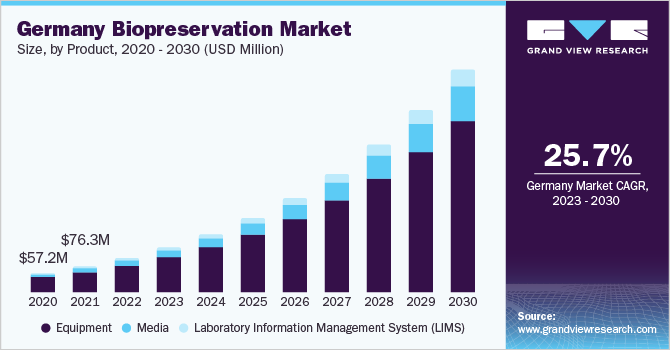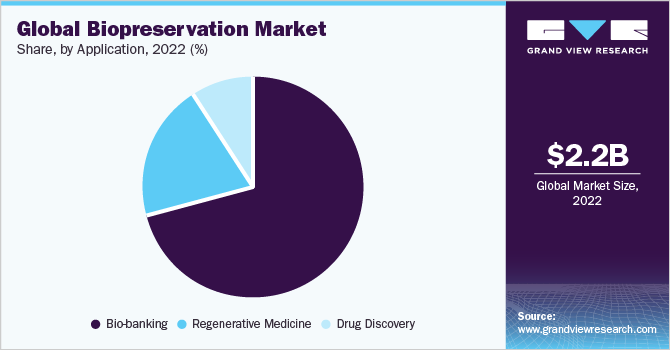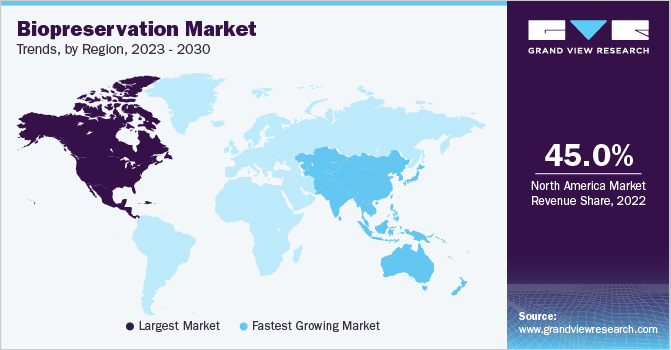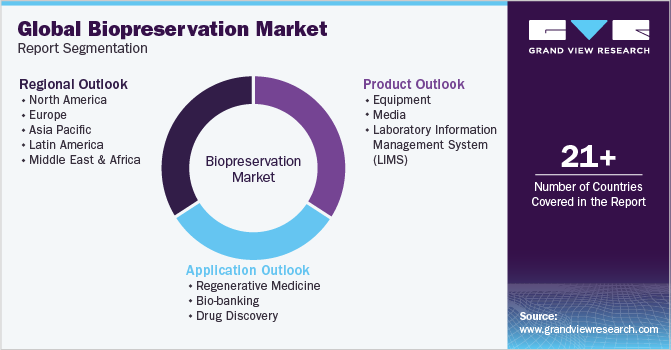- Home
- »
- Biotechnology
- »
-
Biopreservation Market Size, Share & Growth Report, 2030GVR Report cover
![Biopreservation Market Size, Share & Trends Report]()
Biopreservation Market Size, Share & Trends Analysis Report By Product (Equipment, Media, LIMS), By Application (Regenerative Medicine, Bio-banking, Drug Discovery), By Region, And Segment Forecasts, 2023 - 2030
- Report ID: 978-1-68038-582-3
- Number of Report Pages: 120
- Format: PDF, Horizon Databook
- Historical Range: 2018 - 2021
- Forecast Period: 2023 - 2030
- Industry: Healthcare
Biopreservation Market Size & Trends
The global biopreservation market size was valued at USD 2.18 billion in 2022 and is projected to grow at a compound annual growth rate (CAGR) of 28.30% from 2023 to 2030. Biopreservation is experiencing growth due to various factors such as extensive usage in hospitals and labs, rising funding assistance from government and private partners in healthcare, an upsurge in research & development, and growing advancement in terms of product development. For example, in April 2021, BioLife Solutions launched a new high-capacity controlled freezer to cater to the cell and gene therapy market, which helped the company expand its existing product portfolio. The market experienced a major hindrance during the COVID-19 pandemic with supply chain issues, unavailability of raw materials, and hindrances in research activities among other reasons. However, the pandemic also accelerated the growth of novel biologics, and vaccine technologies. Due to these factors, opportunities for biologics manufacturing and preservation are anticipated to increase, thus generating further demand for biopreservation.

Biopreservation is a process that helps maintain the integrity and functionality of biological products such as stem cells, DNA, tissues, and organs under different temperatures, thereby prolonging their lifespan outside their natural environment. Technology innovations include microarrays or incorporation of a wide range of predictive models, such as hybrid models, and various API algorithms which help reduce the time, cost and complexity of the overall process. Furthermore, the advent of multiplex cellular imaging platforms is anticipated to enhance the biopreservation ability to help understand disease progression and suggest suitable diagnostic & treatment measures to follow, specifically for cardiology, gynecology, and point-of-care applications.
In recent years, there has been an upsurge in demand for use of biopreservation to develop biological products in R&D of various sectors such as immunotherapies, vaccine production, antibody production, enzyme technology, and biologically produced chemicals. This impact is due to the rising number of chronic disease incidences globally. For instance, according to the Centers for Disease Control and Prevention, cardiovascular disorders and cancer are among the leading causes of disease-related mortality in adults in the U.S.
Furthermore, the government and private sectors have shown interest and supported funding activities in research & development, leading to immense market developments. In recent years, the growing demand for preserving stem cells and developing biological medicines and products has gained investors' focus in this field. This considerable healthcare spending is expected to fuel market growth during the forecast period.
However, the growing biopreservation market is associated with challenges such as the unavailability of skilled professionals and the lack of stringent cybersecurity measures. The high cost of labor training and software standardization are some of the contributing factors. These challenges could potentially impact overall market growth.
Product Insights
The equipment segment held the highest market share of 78.75% in 2022 due to rising demand for bio-banking to preserve stem cells, DNA, plasma and tissue culture. The widespread acceptance and utilization of preservation have benefited adequate storage capacity and low maintenance is expected to boost the market.
The media segment has the potential to grow as it is a crucial part of the biopreservation process. The segment is expected to grow at a CAGR of 29.99% from 2023 to 2030. Media applications offer more features and details, allowing researchers to access and share research data and analyses, thereby improving their ability to research, diagnose, monitor, and treat health disorders. This trend is anticipated to drive market growth during the forecast period.
Application Insights
The biobanking segment dominated the global market with a share of 70.65% in 2022. Rising awareness for stem cell preservation, increasing acceptance of sperm and egg banking, and utilizing assistant reproductive technology with animals. Pharmaceutical companies have collaborations with reserve bio-banks and tissue preservation with hospitals.

Regenerative medicine segment is expected to grow at a higher CAGR of 29.68% in the given forecast period owing to increasing demand for technologically advanced bio-storage techniques. In addition, launch of specific preservation techniques is expected to propel the segment growth in coming years.
Regional Insights
North America was the largest revenue-generating region in the biopreservation market in 2022 and held a share of 45.00%. This can be attributed to the presence of advancement in biomedical research and the development of advanced therapies. Furthermore, the rising number of chronic incidences that require treatments creates demand for biopreservation in the region which strengthens its market presence. Such activities are expected to contribute toward expanding the biopreservation product available in the market and drive growth.

The U.S has been projected to have significant growth in the biopreservation market owing to government organizations and various bio-banking institutes that contribute to the penetration of biopreservation techniques. For instance, the biospecimen collection in biorepositories and biobanks is supported by funding actives from the National Institutes of Health (NIH) whereas, National Cancer Institute (NCI) contributes to managing such bio-banking programs. These biobanks support research and clinical trial programs in the country thereby increasing the demand for biopreservation techniques.
Asia Pacific is expected to be the fastest-growing region with a CAGR of 30.47% due to the rising funding support for techniques and services in bio-banking, and increasing partnerships and collaborations following biopreservation techniques.
Key Companies & Market Share Insights
Key players in the market are opting for strategic initiatives, funding facilities for geographical expansion, partnerships, mergers and acquisitions in key regions. For instance, in January 2023, the Hamad Medical Corporation and Qatar BioBank launched a new tissue biobank service in Qatar to provide researchers the access to high-quality tissue samples. Some of the key players in the biopreservation market include:
-
Azenta US, Inc.
-
Biomatrica, Inc.
-
BioLife Solutions
-
MVE Biological Solutions
-
LabVantage Solutions, Inc.
-
Taylor-Wharton.
-
Thermo Fisher Scientific, Inc.
-
Panasonic Corporation
-
X-Therma Inc.
-
PrincetonCryo.
-
Stirling Ultracold
Biopreservation Market Report Scope
Report Attribute
Details
Market size value in 2023
USD 2.90 billion
Revenue forecast in 2030
USD 16.61 billion
Growth rate
CAGR of 28.30% from 2023 to 2030
Base year for estimation
2022
Historical data
2018 - 2021
Forecast period
2023 - 2030
Report updated
May 2023
Quantitative units
Revenue in USD billion and CAGR from 2023 to 2030
Report coverage
Revenue forecast, company ranking, competitive landscape, growth factors, and trends
Segments covered
Product, application, region
Regional scope
North America; Europe; Asia Pacific; Latin America; Middle East & Africa
Country scope
U.S.; Canada; Germany; U.K.; France; Spain; Italy; Denmark; Sweden; Norway; Japan; China; India; Australia; Thailand; South Korea; Brazil; Mexico; Argentina; South Africa; Saudi Arabia; UAE; Kuwait
Key companies profiled
Azenta US, Inc.; Biomatrica, Inc.; BioLife Solutions; MVE Biological Solutions; LabVantage Solutions, Inc.; Taylor-Wharton; Thermo Fisher Scientific, Inc.; Panasonic Corporation; X-Therma Inc.; PrincetonCryo.; Stirling Ultracold
Customization scope
Free report customization (equivalent up to 8 analyst’s working days) with purchase. Addition or alteration to country, regional & segment scope.
Pricing and purchase options
Avail of customized purchase options to meet your exact research needs. Explore purchase options
Global Biopreservation Market Report Segmentation
This report forecasts revenue growth and provides an analysis on the latest trends in each of the sub-segments from 2018 to 2030. For the purpose of this report, Grand View Research has segmented the global biopreservation market report on the basis of product, application, and region:

-
Product Outlook (Revenue, USD Billion, 2018 - 2030)
-
Equipment
-
Freezers
-
Refrigerators
-
Consumables
-
Vials
-
Straws
-
Microtiter Plates
-
Bags
-
-
Liquid Nitrogen
-
-
Media
-
Pre-formulated
-
Home-brew
-
-
Laboratory Information Management System (LIMS)
-
-
Application Outlook (Revenue, USD Billion, 2018 - 2030)
-
Regenerative Medicine
-
Cell Therapy
-
Gene Therapy
-
Others
-
-
Bio-banking
-
Human Eggs
-
Human Sperms
-
Veterinary IVF
-
-
Drug Discovery
-
-
Regional Outlook (Revenue, USD Billion, 2018 - 2030)
-
North America
-
U.S.
-
Canada
-
-
Europe
-
Germany
-
U.K.
-
France
-
Italy
-
Spain
-
Denmark
-
Sweden
-
Norway
-
-
Asia Pacific
-
China
-
Japan
-
India
-
Australia
-
Thailand
-
South Korea
-
-
Latin America
-
Brazil
-
Mexico
-
Argentina
-
-
Middle East and Africa (MEA)
-
South Africa
-
Saudi Arabia
-
UAE
-
Kuwait
-
-
Frequently Asked Questions About This Report
b. The global biopreservation market size was estimated at USD 2.18 billion in 2022 and is expected to reach USD 2.90 billion in 2023.
b. The global biopreservation market is expected to grow at a compound annual growth rate of 28.3% from 2023 to 2030 to reach USD 16.61 billion by 2030.
b. North America dominated the biopreservation market with a share of 45% in 2022. This is attributable to consistent drug developments and the advent of advanced therapies in the field of biomedical research.
b. Some key players operating in the biopreservation market include BioLife Solutions Inc.; BioCision; Biomatrica; Chart MVE Biomedical; LabVantage Solutions, Inc.; Atlanta Biologics Inc.; Taylor-Wharton Cryogenics LLC; Panasonic Corporation; Thermo Fisher Scientific, Inc.; Qiagen N.V.; VWR International, LLC; and BIOGENICS.
b. Key factors that are driving the market growth include growing healthcare expenditure, the presence of government healthcare initiatives that provide funds, grants, and contracts for research, technological advancements in biopreservation processes, and increasing R&D investments by companies and research communities to enhance their capabilities and render efficient products and services.
Share this report with your colleague or friend.
![gvr icn]()
NEED A CUSTOM REPORT?
We can customize every report - free of charge - including purchasing stand-alone sections or country-level reports, as well as offer affordable discounts for start-ups & universities. Contact us now
![Certified Icon]()
We are GDPR and CCPA compliant! Your transaction & personal information is safe and secure. For more details, please read our privacy policy.
We are committed towards customer satisfaction, and quality service.
"The quality of research they have done for us has been excellent."





